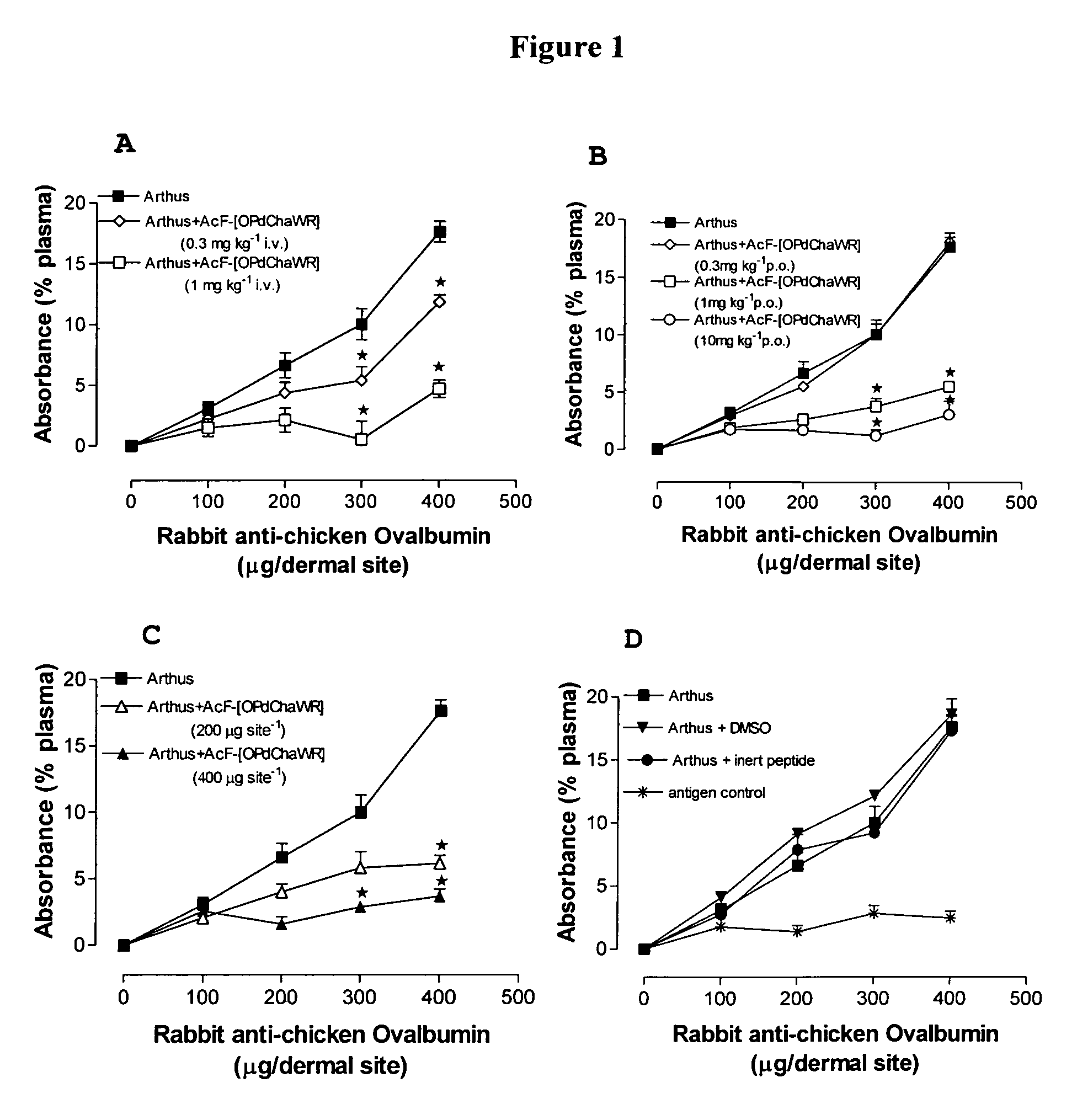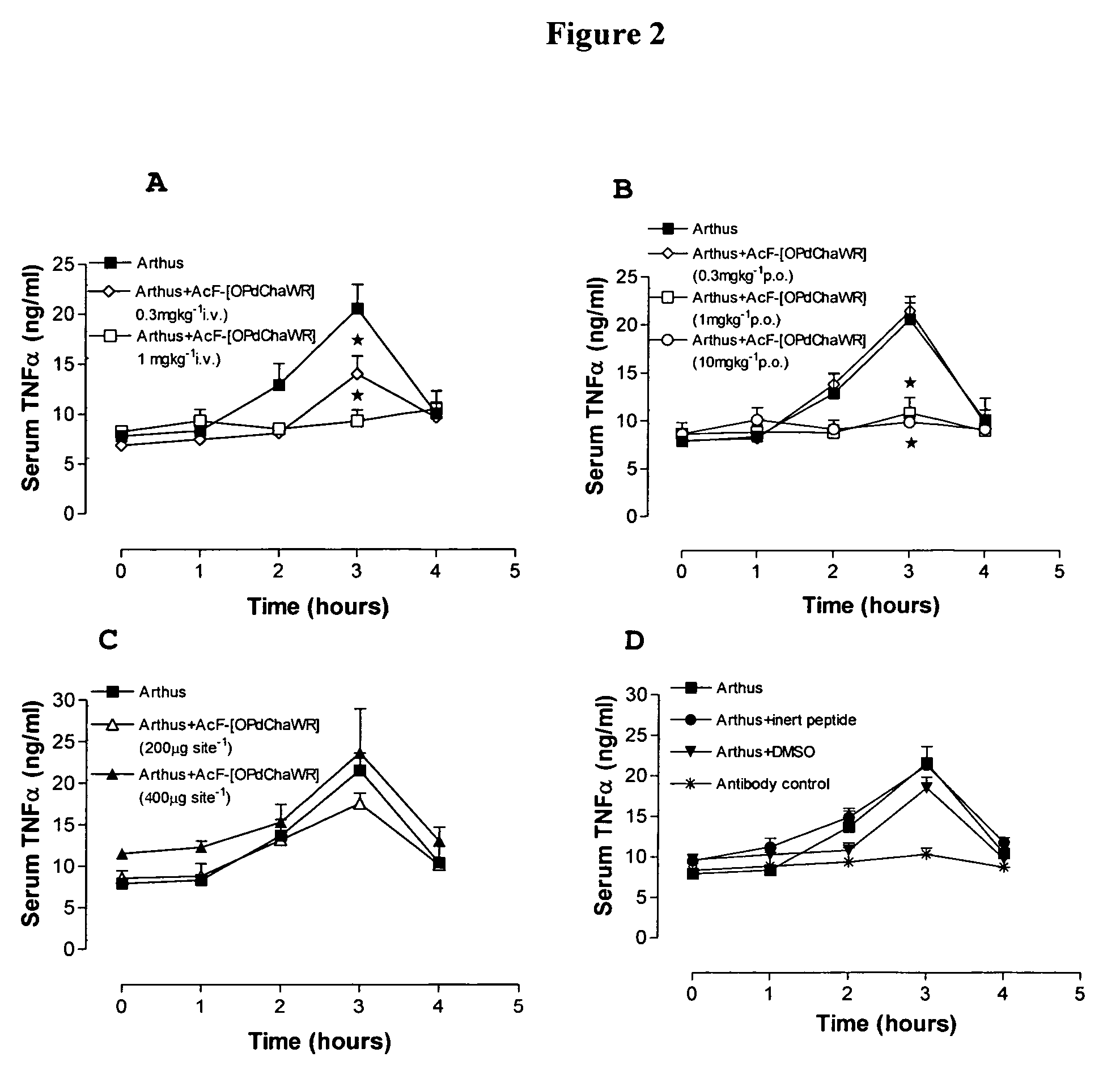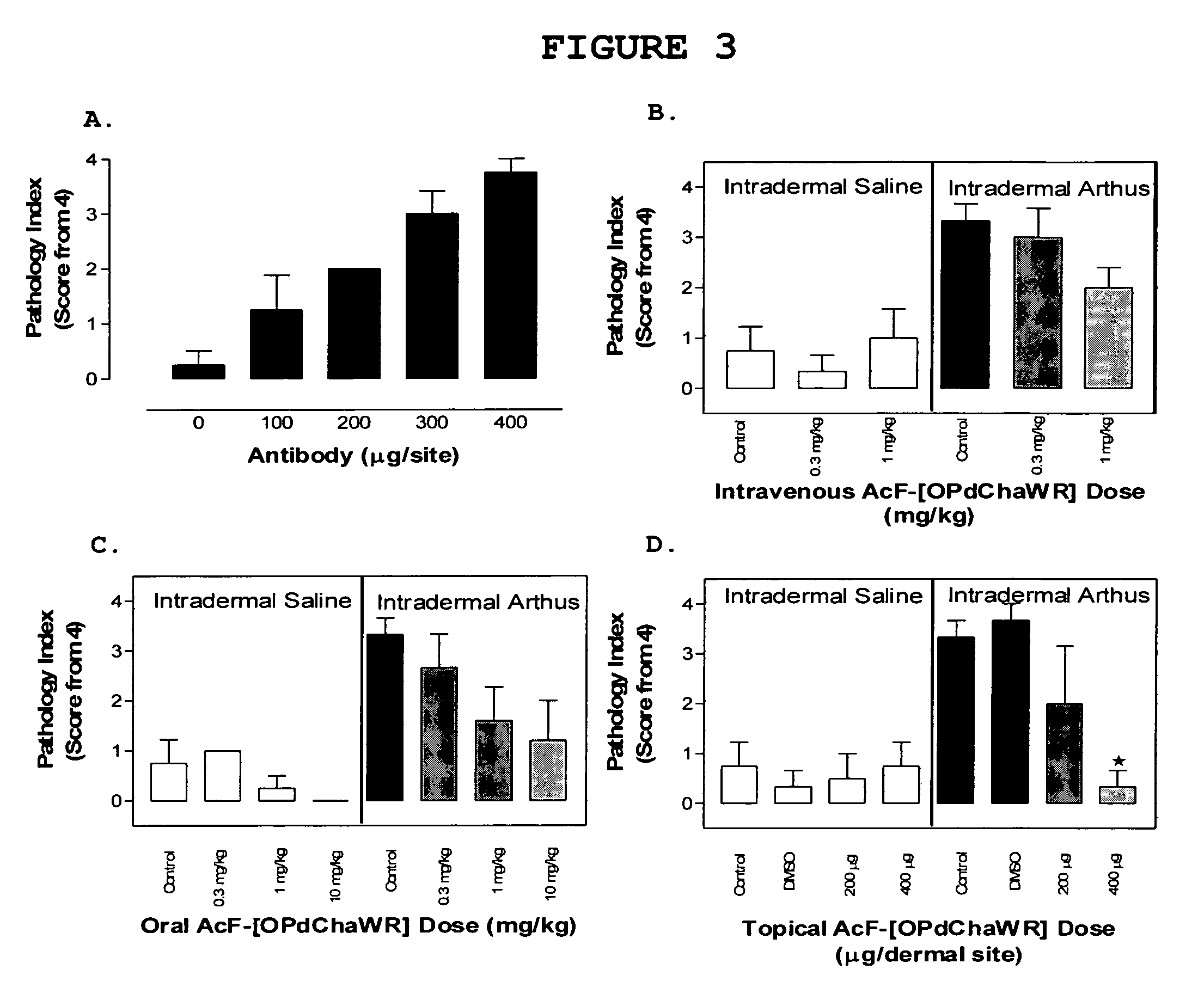Cyclic peptides as G-protein-coupled receptor antagonists
a gprotein-coupled receptor and peptide technology, applied in the field of cyclic compounds, can solve the problems of producing both high and low antagonist potencies which were not accurately predicted
- Summary
- Abstract
- Description
- Claims
- Application Information
AI Technical Summary
Benefits of technology
Problems solved by technology
Method used
Image
Examples
example 1
Synthesis of Cyclic Compounds
[0117]Synthesis of cycle AcF-[OPdChaWR] (1). The linear peptide Ac-Phe-Orn-Pro-dCha-Trp-Arg was synthesised by Boc chemistry on a 0.20 mmole scale using HBTU / DIEA activation and in situ neutralisation on a Boc-L-Arg(Tos)-PAM resin (338 mg, SV=0.591 mmol / g). Cleavage and deprotection of the resin (457 mg) was achieved by treating the resin with HF (10 ml) and p-cresol (1 ml) at −5 to 0° C. for 1-2 hrs, to give crude peptide (160 mg, 90%). Cyclisation involved stirring the crude peptide (41 mg, 45 μmol), BOP (126 mg, 0.28 mmol) and DIEA (158 μL, 0.9 mmol) in DMF (57 mL) for 15 hrs. The solvent was removed in vacuo and the cyclic peptide purified by rpHPLC (18.8 mg, 47%) Rt=10.8 min (gradient 70% A / 30% B to 0% A / 100% B over 30 min). MS: [M+H]+ (calc.)=896.5, [M+H]+ (exper.)=896.5.
[0118]Synthesis of cycle AcF-[OPdPheWR] (33). The linear peptide Ac-Phe-Orn-Pro-dPhe-Trp-Arg was synthesised by Boc chemistry using HBTU / DIEA activation and in situ neutralisation ...
example 2
Antagonist Activity of Cyclic Compounds
[0126]Table 2 shows the structures of the compounds synthesised in Example 1, as well as their respective receptor binding affinities and antagonist potencies for the C5a receptor on human polymorphonuclear leukocytes (neutrophils), as measured by the myeloperoxidase assay.
[0127]Compounds 1-9, 16-18, 20, 21, 23, 24, 27-32, 36, 38, 44, 51, and 59 are within the broad scope of the general structure set out in our earlier patent application No. PCT / AU98 / 00490. However, Table 2 demonstrates that in fact, of these compounds, only 1-6, 17, 20, 28, 30, 31, 36 and 44 have appreciable antagonist potency (IC501 μM in all cases.
[0128]On the other hand, compounds 10-15, 19, 22, 25, 26, 33-35, 37, 39-43, 45, 47-50, 52-58, and 60-70 are not included within the scope of PCT / AU98 / 00490, although they do involve the same or similar cyclic scaffolds to those disclosed therein. Table 2 shows that of these new compounds, 10-12, 14, 15, 25, 33, 35, 40, 45, 48, 52, ...
example 3
Cyclic Antagonists of C5a
[0131]Some examples of these cyclic antagonists and their apparent receptor-binding affinities and antagonist potencies are given in Table 3, in which the single letter code for amino acids is used. “d” indicates the dextro (D) form of an amino acid. “ND” indicates not determined.
[0132]
TABLE 3NEW COMPOUNDS AS C5a ANTAGONISTSCompoundBindingAntagonistAcPhe ReplacementsNumbernIC50 (μM)IC50 (nM)MsF[OP-dCha-WR]1030.4734TsF[OP-dCha-WR]1130.96291AcPhg[Opd-Cha-WR]1230.76151AcG[OP-dCha-WR]13337.2NDAc(o-fluoro)F[OP-1430.5238dCha-WR]Ac(m-fluoro)F[OP-1510.39NDdCha-WR]HC[OP-dCha-WR]1730.2231Hydrogen[OP-dCha-WR]193>1000NDMs = Mesyl, Ts = Tosyl, MeSuc = Methylsuccinate, Suc = Succinate,Ahx = 6-Aminohexanoate, HPhe = Homophenylalanine,Phg = Phenylglycine, HC = Hydrocinnamate ND = not doneCompoundBindingAntagonistPro ReplacementsNumbern(μM)(nM)AcF[O-Hyp-dCha-WR]2530.27NDAcF[O-Thp-dCha-WR]26175.5NDAcF[O-Phe-dCha-WR]2232.43NDHyp = trans-Hydroxyproline, Thp = cis-ThioprolineBin...
PUM
| Property | Measurement | Unit |
|---|---|---|
| temperature | aaaaa | aaaaa |
| temperature | aaaaa | aaaaa |
| temperature | aaaaa | aaaaa |
Abstract
Description
Claims
Application Information
 Login to View More
Login to View More - R&D
- Intellectual Property
- Life Sciences
- Materials
- Tech Scout
- Unparalleled Data Quality
- Higher Quality Content
- 60% Fewer Hallucinations
Browse by: Latest US Patents, China's latest patents, Technical Efficacy Thesaurus, Application Domain, Technology Topic, Popular Technical Reports.
© 2025 PatSnap. All rights reserved.Legal|Privacy policy|Modern Slavery Act Transparency Statement|Sitemap|About US| Contact US: help@patsnap.com



